On this page:
WORLDTIMER FACEOFF — SEIKO V. CITIZEN
A REVIEW BY LES ZETLEIN
PAGE 3 OF 3
(Note: Click on thumbnails to enlarge photos.)
| « previous page |
|
|
On this page: |
WORLDTIMER FACEOFF — SEIKO V. CITIZEN A REVIEW BY LES ZETLEIN PAGE 3 OF 3 (Note: Click on thumbnails to enlarge photos.) |
|
|
Wheels within Wheels
RIGHT, WHERE WERE WE THEN? Oh yes, we're looking at a couple of 1970s worldtimer models, a Seiko and a Citizen. And here they are:
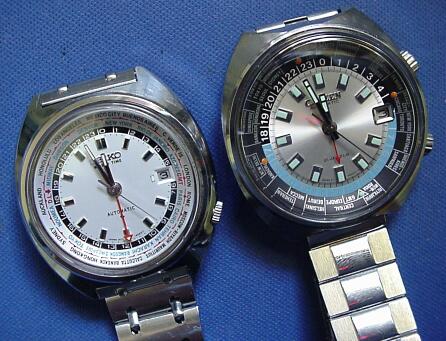 Going by the serial numbers, the Seiko (on the left) was made in July 1975, and the Citizen in October 1973. Thus they were sold in direct competition with each other, and before the quartz revolution had really taken hold (Seiko was the first to market an analogue quartz watch, the Astron, in 1969). In contrast with watches with a settable 24-hr hand, which tell you local time and time in a second zone (usually GMT) and that's all, the fixed-gear 24-hr hand on these two plus the rotatable inner bezel allow you to simultaneously check out the time anywhere in the world. It's really a very simple idea, and very easy to use. Here's how it works. 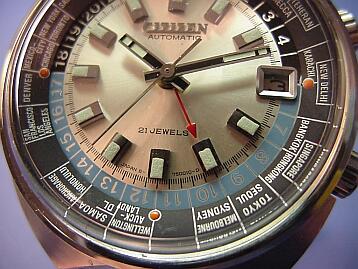 1. Rotate the inner bezel until your timezone (in this case, Sydney) is opposite the 24-hr pointer.
1. Rotate the inner bezel until your timezone (in this case, Sydney) is opposite the 24-hr pointer.2. Look for the timezone you want, and read off the time on the hour scale around the outside of the dial. As an example, say we want to know the time in Denver, Colorado. (Nice place, Denver. Reminds me more than a little of Adelaide.) The hour scale indicates 17 or 5.00pm. Using a little bit of interpolation and noting the minute hand, we can say that when it's 10.12am in Sydney, it's 5.12pm in Denver (the previous day, of course). Naturally, this method doesn't take into account any daylight savings that might be in force. For that, you need to do a little mental gymnastics or use an electronic watch such as the Citizen Navihawk or Skyhawk, which does it all for you. One disadvantage of this method is that you need to reset the bezel to the pointer every time. There's no way to keep the two timezones 'in sync' as it were, as is done automatically with electronic watches.
ALTHOUGH CITIZEN WATCHES of recent years (especially the quartz 'Promaster' series) have had colourful—if not to say gaudy—designs, Citizen watches of the '70s were rather staid on the whole. This Worldtimer comes as a bit of a surprise then, with its chunky applied hour markers laden with green luminescent material, and overall 'dartboard'-like dial. 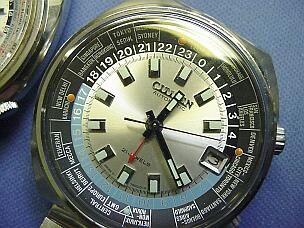 The large (42mm dia.) '70s-style cushion case with its two crowns at 2 and 4 o'clock complements the funky effect. The non-original 'Stelux' stainless steel single deployant bracelet suits the character of the watch, and has solid links held together with solid pins with a figure-of-eight cross section. The links are polished on the inside face and have a combination sculptured brushed/polished finish on the outside. The overall effect is quite pleasing and the bracelet feels sturdy and comfortable to wear. My wrist is 7½" circumference and there's another ¾" adjustment left in the clasp.
The large (42mm dia.) '70s-style cushion case with its two crowns at 2 and 4 o'clock complements the funky effect. The non-original 'Stelux' stainless steel single deployant bracelet suits the character of the watch, and has solid links held together with solid pins with a figure-of-eight cross section. The links are polished on the inside face and have a combination sculptured brushed/polished finish on the outside. The overall effect is quite pleasing and the bracelet feels sturdy and comfortable to wear. My wrist is 7½" circumference and there's another ¾" adjustment left in the clasp.The solid stainless steel case has a pleasing heft to it. It has a circular grain on its upper surface and is polished everywhere else. A screw-in stainless steel back helps keep dirt and water out. On the inside of the back is an O-ring seal and a waved circlip which presses down on the case as the back is tightened. This helps prevent the back accidentally working itself loose. 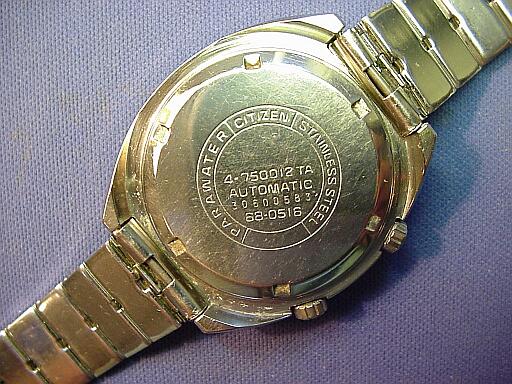 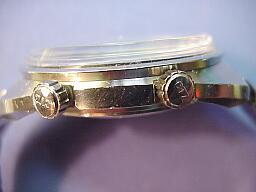 The two crowns are identical, are both signed 'CTZ', and are largely protected by the case. The crown at 2 o'clock moves the inner 'cities' bezel bi-directionally; the one at 4 o'clock winds the mainspring, advances the quickset date (first indent), and hacks (stops) the movement and allows setting of the hands (second indent). Although the crowns are ridged the ridges are wide, and this together with the fairly small crown diameter (5.5mm) and stiff resistance makes handwinding difficult. Still, not too much handwinding should be required.
The two crowns are identical, are both signed 'CTZ', and are largely protected by the case. The crown at 2 o'clock moves the inner 'cities' bezel bi-directionally; the one at 4 o'clock winds the mainspring, advances the quickset date (first indent), and hacks (stops) the movement and allows setting of the hands (second indent). Although the crowns are ridged the ridges are wide, and this together with the fairly small crown diameter (5.5mm) and stiff resistance makes handwinding difficult. Still, not too much handwinding should be required.The dial and rotating bezel, as mentioned previously, are certainly very colourful but it is only when the dial is viewed under a loupe that the quality of the manufacture can be appreciated. The underlying dial face is silver-coloured with a light sunburst finish. The Citizen logo and hour markers are applied absolutely precisely, and have a bright (rhodium plated?) finish, as do the hands and frame around the date window. The city names are printed in silver on a matt black background, and this combination together with the small print size makes the city names rather hard to distinguish. The bezel carries three orange dots at GMT +6h, +12h and -6h respectively, plus a luminous green dot at GMT itself. The 24-hr hand, which doesn't extend to the hour markers, is painted red and makes one traverse of the dial in 24 hours. When eclipsed by the minute hand it is covered completely. There is plenty of luminous material still present on the hands and markers, but it only glows very briefly when exposed to light. If it was all replaced with superluminova the resulting display would be something to see. The crystal is flat acrylic and stands 2.5mm above the case. Reflections are minimal. 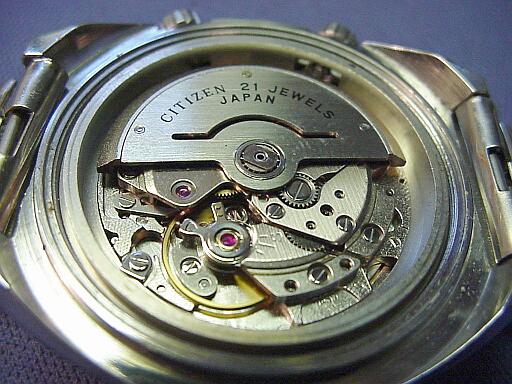 Overall, with normal daily wear and left dial up overnight, the Citizen showed a steady gain of 7 seconds per day. This is an excellent result in itself but I suspect even this could be improved upon after a service and regulation.
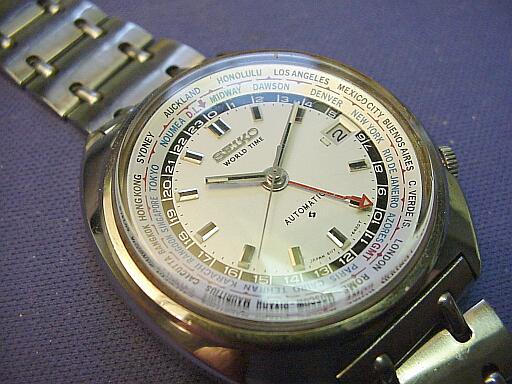 AT FIRST GLANCE the Seiko seems quite a bit smaller than the Citizen, but the the difference is mostly illusory: the Seiko's measurements are within a millimetre of the Citizen's. The width of the case, for example, is 41mm whereas the Citizen's is 42mm. The case thickness is identical at 13mm. Like the Citizen, the Seiko's case is cushion-shaped, made from solid stainless steel and has a good heft. It's polished all over, and the printing on the screw back indicates it's water resistant, although a depth is not stated. There is an O-ring in the case back, but this particular example is very tired and needs replacing. 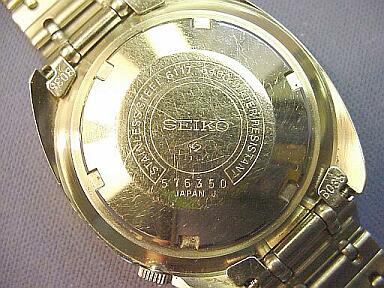 The single deployant, signed clasp, steel bracelet looks original and has folded links. It is of what I call the "Jacob's ladder" style, typical of Seiko watches of the period. It's comfortable but only just fits my 7½" wrist—there's no adjustment left in the clasp. The links look polished on the outside but there's a brushed pattern there too. 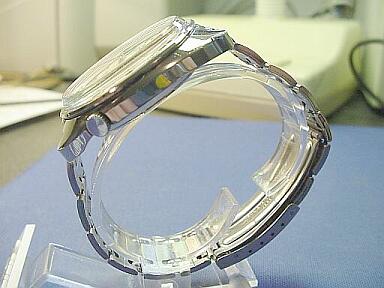 Recessed into the case at the four o'clock position is the rather small 5mm dia. crown. When nestled into the case it can easily be rotated by rolling a finger over it to move the timezone bezel. At the first detent the quickset date can be adjusted (forwards only), and at the second detent the movement is hacked and the hands can be adjusted.  The Seiko dial is less in-your-face than the Citizen's, but is just as nicely put together. The hour markers and logo are applied, and are bright-metal finished as are the hands. There is a minimal amount of luminous material on the hands and hour markers, but like the Citizen, the glow doesn't last long at all. To the naked eye the dial seems plain finished in a matt silver, which provides a good contrast for the baton hands. Under the loupe however a faint but clearly discernible linen pattern is evident. The city names around the bezel are in black or blue paint against a matt silver background, and are slightly larger than those on the Citizen. All this makes them more readable. 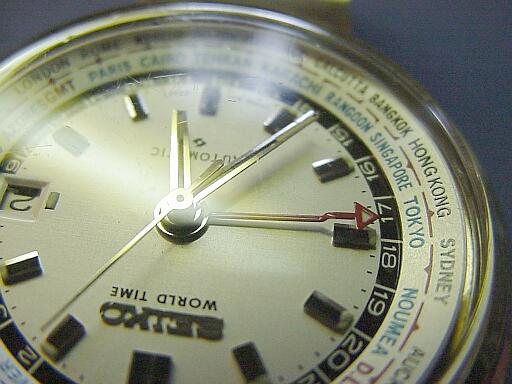 The red 24-hour hand extends all the way to the edge of the dial, and Seiko have employed a neat trick to allow the hand to pass over the hour markers whilst at the same time minimising the height of the watch—it's cranked at its outer end. It remains visible even when covered by the minute hand. The acrylic crystal is remarkably similar in shape to that on the Citizen—flat and about 2mm proud of the case. At 35mm across, it's 3mm smaller than the Citizen. It could well be that both crystals have been replaced at some time by generic equivalents. 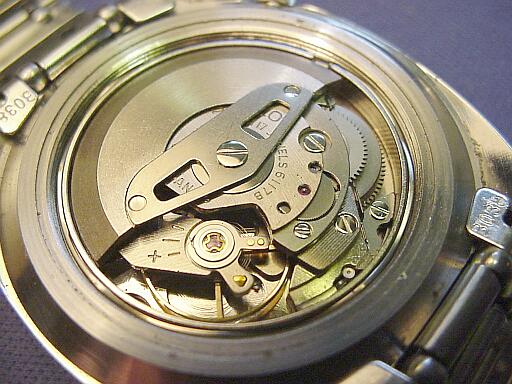 The movement is the cal. 6117B, with 17 jewels and bi-directional autowind, beating at 21,600 vph. It is not hand-windable, but it does hack. Seiko's 'diashock' shock protection system is used. In the usual Seiko way the movement is functionally but neatly finished, even to the extent of polished screw heads (like the Citizen). A flat hairspring drives a monometallic, screwless balance. If held up to the ear the movement can just be heard ticking quietly away, although the winding system has the typical noisy Seiko rattles and clonks. When it is on the wrist though, one is not aware of the turmoil within, and the winding system works well. The date change starts at 10.15pm and is complete by 11.55pm. Worn during the day and left dial up at night, the Seiko ran at a steady +30 secs/day. This rate is somewhat greater than I have experienced with other Seikos, and no doubt reflects the need for a service and regulation. I would expect a rate of well under +/-10 secs/day to be easily achieved. Head to Head Comparison
* Citizen model numbers are notoriously difficult to determine. Often the model number is completely unrelated to any caseback markings. Conclusions AS CAN BE SEEN FROM THE ABOVE TABLE, there's not a lot to choose between the Citizen and the Seiko in terms of construction, features or performance (assuming the Seiko's daily rate would improve after servicing). They both ran effortlessly and never gave any trouble. So it comes down to the little things. 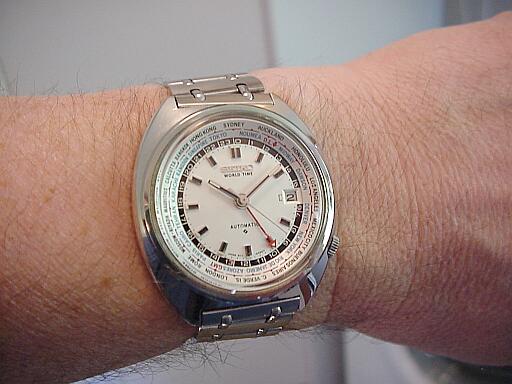 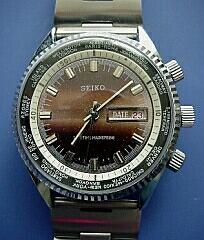 If your eyesight is good or you only use the world time feature occasionally, the Citizen offers a refined movement, an unusual dial, a larger-looking case, exemplary timekeeping and the ability to hand wind. Which would I choose? Well, it's a tough call but I think I'd have to go for the Citizen. It just seems to be of slightly higher quality all round (those older Citizen movements were very well put together), it's rarer, it's big and bold and I like the fact you can wind it manually. And who could resist that funky 1970s dial? Not me!  Acknowledgements John Gaskin of Adelaide Time, for the loan of the watches. Let me say at the outset that in putting together the material on Enigma I have borrowed very heavily (if not to say shamelessly) from three sources in particular. The first of these is the Simon Singh book, The Code Book. This is a very informative and entertaining read, and is recommended for anyone with an interest in cryptology and cryptanalysis. The second source is another book, Enigma - The battle for the code by Hugh Sebag-Montefiore. This tells the more personal experiences of the Enigma story and also concentrates on how 'pinches' were obtained from German weatherships and U-boats, often in appalling and dangerous weather conditions. (In an interesting slant, Sebag-Montefiore is the great-great grandson of Sir Herbert Leon, the original builder and occupier of Bletchley Park. Sir Herbert died in 1926, but his wife Fanny continued to live there until her death in 1937, after which the property was sold to a developer.) This book is also highly recommended. The third source is the excellent website http://www.turing.org.uk/turing, devoted to life and work of Alan Turing (written and maintained by Andrew Hodges). These and other sources are listed in full below. All make worthwhile reading. I must also say that while Hans-Thilo Schmidt did have affairs with his maids, my description of what he did with Gerda is entirely fictional, as is Gerda herself. But it was fun making it up.
References
|
| « previous page |